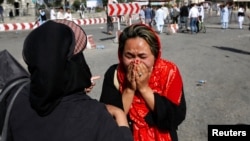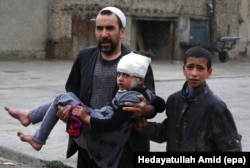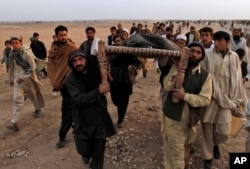More than 5,100 civilians, including some 1,500 children, have been killed or injured in Afghanistan in just the first six months of this year, the United Nations reported Monday.
For that period, the U.N. reports 1,601 civilian deaths and 3,565 injured civilians, a 4 percent rise compared with 2015.
The overall casualties are the highest half-year total since the U.N. Assistance Mission in Afghanistan - UNAMA - began counting. The report notes that nearly 64,000 civilians in Afghanistan have been killed or maimed since counting began in January 2009.
The report blames the Taliban, Islamic State and other so-called anti-government elements for a majority of civilian casualties. It also finds, however, that the number of casualties by pro-government forces is increasing. Ground attacks, followed by suicide bombings and unexploded remnants of war, cause the greatest harm.
Victims playing, praying
The report presents stark testimony by victims and their families of the agonizing impact these attacks have upon their lives. U.N. human rights spokeswoman, Ravina Shamdasani tells VOA the victims come from all sectors of society.
“We are talking about children who are going outside to play and they never come back," she said. "We are talking about this one woman who was sitting down to pray and a bomb went off nearby and she died. There was one case of a shepherd who was minding his own business herding his sheep and pro-government elements showed up and beat him up with a stick. And, they beat him so hard that the stick broke trying to get information from him."
Shamdasani said the report also documents a host of serious human rights violations and abuses. She said female politicians and police officers are deliberately targeted, threatened, intimidated and, in some cases, killed.
“There is also the use of children, the recruitment and the use of children in armed conflict, sexual violence against boys and girls. Attacks on educational facilities, attacks on health facilities, abductions of civilians, including mass abductions, summary executions,” Shamdasani said.
Shamdasani added that human rights defenders, lawyers, journalists and judges are particularly vulnerable.
She said the deliberate targeting of civilians and the use of heavy weaponry in civilian-populated areas may constitute war crimes or crimes against humanity. She also said civilian casualties must be investigated and perpetrators brought to justice.
Breakdown of numbers
Almost one-third of the casualties — 1,509 — were children, UNAMA said in its mid-year report, describing the figure as "alarming and shameful."
"Although women casualties decreased by 11 percent, one in 10 civilian casualties was a woman. Child casualties increased by 18 percent. Almost one out of every three casualties from this conflict is a child," UNAMA director for human rights, Denielle Bell, told reporters.
She said ground fighting between parties caused a 23 percent increase in civilian casualties from last year, followed by complex and suicide attacks, and improvised explosive devices, or IEDs.
"While anti-government forces continued to cause the majority of civilian casualties, the mid-year report documents a 47 percent increase in civilian casualties resulting from pro-government forces, causing 1,180 civilian casualties, or 23 percent of total civilian casualties," Bell said.
The report blamed the Taliban and other militant groups for 60 percent of the overall casualties. That represents an 11 percent decrease from 2015, Bell noted, adding that the decrease resulted mainly from fewer civilian casualties from targeted killings and IEDs.
The UNAMA report attributed approximately 1 percent of the civilian casualties to the U.S.-led international forces, mainly caused by airstrikes.
UNAMA Chief Tadamichi Yamamoto lamented that all parties to the Afghan conflict have failed to implement public pledges to protect civilians.
"All the parties to the conflict have already publicly stated they need to avoid civilian casualties,” Yamamoto said. “However, parties need to get beyond rhetoric to real changes on the ground."
The report also documented 122 civilian casualties caused by loyalists of the Syrian-based Islamic State terror group, which is commonly referred to in Afghanistan as Daesh, the Arabic acronym for IS.
Yamamoto expressed concerns about an increase in IS attacks, but insisted the extremist group does not enjoy support among Afghans and is under attack by government and foreign forces, as well as the rival Taliban.
IS claimed responsibility for Saturday's suicide bombing of a mass protest rally in Kabul. The attack left at least 80 people dead and more than 200 wounded.
Am earlier version of this report incorrectly listed the number of civilian deaths at more than 5,100. VOA regrets the error.












